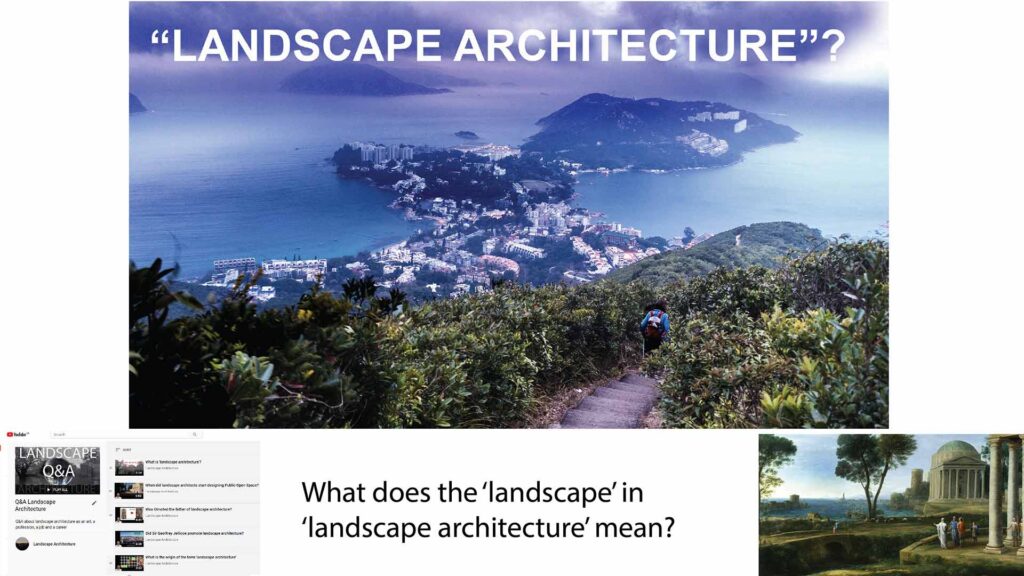What does ‘landscape’ mean in the term ‘landscape architecture’? Q&A

Question: How should the term ‘landscape’ be understood in the phrase ‘landscape architecture’?
Short answer. Its meaning takes something from its use but by artists, poets and geographers but draws mainly upon its use, in a ‘Designer’s Sense’, in eighteenth century England. Typically, a designed landscape was, as it remains, a place where landform, water and plants have been composed with buildings and pavings for human use and enjoyment.
Longer answer: The Oxford English Dictionary entry for the word ‘landscape’ traces its etymology to Old Saxon and Old English. It dropped out of use in Old English and then came back, from Holland in the seventeenth century, as a painter’s term. This is defined (in OED sense 1.a) as ‘A picture representing natural inland scenery, as distinguished from a sea picture, a portrait, etc.’
During and after the eighteenth century, ‘landscape’ was used in various compounds. Many are obsolete. But others survive. Landscape-gardening is defined as ‘the art of laying out grounds so as to produce the effect of natural scenery’. And Landscape Architecture is defined as ‘the planning of parks or gardens to form an attractive landscape, often in association with the design of buildings, roads, etc.’
Towards the end of the nineteenth century, geologists and geographers began using the word landscape (as defined in OED sense 2.b) to mean ‘A tract of land with its distinguishing characteristics and features, esp. considered as a product of modifying or shaping processes and agents’. The OED has 1886 as its first example of this geographers’ use of landscape and 1840 as the first example of the term ‘landscape architecture’. This is cited as ‘J. C. Loudon in H. Repton Landscape Gardening & Landscape Architecture. of H. Repton ‘. I wrote to the editors of the OED in the 1980s to suggest the inclusion of Gilbert Laing Meason’s 1828 use of the term. So far, it has not been included – possibly because they think, wrongly in my view, that Loudon and Meason did not use the word in the same sense.
To understand and explain the term ‘landscape architecture’ one has to bear in mind the distinct connotations of the word in the three OED senses I have quoted.
For painters and geographers every kind of outdoor scene is a landscape, including mountain tops, wild rivers, deserts, jungles, oil refineries and industrial wastelands. Some of them are natural, others are man-made. Some are beautiful and productive. Others are ugly, sterile and dangerous. Only a few geographers and painters ‘landscapes’ are ‘works of landscape architecture’. And those which come into this category usually satisfy the three Vitruvian design aims: they rate well for visual quality, social quality and ecological quality.
We also need to note three other points:
- The painters’ use of ‘landscape’ developed in the context of Plato’s Theory of Art. Renaissance artists aimed to represent ideal places, rather than real places, in their ‘landscape’ works. This aim rests on what is called the Neoplatonic, or Platonic or Ideal, Theory of Art.
- Geographers and geologists use the word ‘landscape’, in a very different way. They seek to understand landscapes as products of ‘modifying or shaping processes and agents (usually natural)’. It’s an evolutionary use of the term
- Designers’ use of the word ‘landscape’ sits midway between that of painters and geographers. When discussing design aims we use it with a positive connotation. We aim to make GOOD places. In Vitruvian terms, they are places with utilitas, firmitas and venustas – which are often translated into English as Commodity, Firmness and Delight. For landscape architecture, Ian Thompson’s translations, as Community, Ecology and Delight, are more appropriate.
If we ignore the the distinct uses of the word ‘landscape’ by artists, geographers and designers we end up with terminological anxiety noted by Olmsted, Mawson, Jellicoe, and me, in a video which asks:
‘What are the problems with the term “landscape architecture”?’. Seriously, they need to be resolved. In one way or in another way, it must be done.
